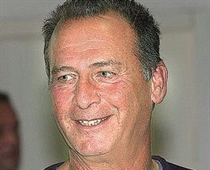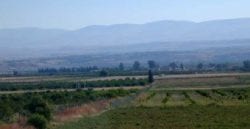 A terrible tragedy occurred on Friday. Sraya Ofer, a 61 year old retired colonel in the Israeli Army was axed to death by Arab terrorists in his home in the Jordan Valley. His wife Monique managed to crawl towards the highway and call for help, but it was too late for her husband. Monique was rushed to the hospital with injuries of her own, but she will survive.
A terrible tragedy occurred on Friday. Sraya Ofer, a 61 year old retired colonel in the Israeli Army was axed to death by Arab terrorists in his home in the Jordan Valley. His wife Monique managed to crawl towards the highway and call for help, but it was too late for her husband. Monique was rushed to the hospital with injuries of her own, but she will survive.
The Ofer family lived in Brosh HaBika, a small area in the northern part of the Jordan Valley that many years ago had been an army base. Some years ago, Ofer converted the place into a vacation village, with varying success, but he continued to live there.
 In 2005, I encountered Brosh HaBika for the first time. It was just after the horrible disengagement from Gaza and the former residents of a small community named Shirat HaYam, Hebrew for the Song of the Sea, were searching for a place to call home. They had been forced from their homes in Gush Katif but didn’t want to live in hotels for months. They wanted to start again in a place that needed settlement. They spent a few weeks in Kedumim, at the empty dormitories of the girls’ high school, until school began. Then they moved to Alon Shvut, where they spent time in empty dormitories in that community. Finally, they found the Jordan Valley and decided that is where they wanted to relocate. Their first stop in the Jordan Valley was at Brosh HaBika, a vacation village totally unsuited for long-term living for families. But for a few months, it was home.
In 2005, I encountered Brosh HaBika for the first time. It was just after the horrible disengagement from Gaza and the former residents of a small community named Shirat HaYam, Hebrew for the Song of the Sea, were searching for a place to call home. They had been forced from their homes in Gush Katif but didn’t want to live in hotels for months. They wanted to start again in a place that needed settlement. They spent a few weeks in Kedumim, at the empty dormitories of the girls’ high school, until school began. Then they moved to Alon Shvut, where they spent time in empty dormitories in that community. Finally, they found the Jordan Valley and decided that is where they wanted to relocate. Their first stop in the Jordan Valley was at Brosh HaBika, a vacation village totally unsuited for long-term living for families. But for a few months, it was home.
These two associations with Brosh HaBika seem tenuous at best. I am assuming that Sraya Ofer was involved in hosting the families from Shirat HaYam, but I can’t be sure. I visited the Shirat HaYam people in Brosh HaBika, but I can’t remember who was running the place at the time.
But remembering the trauma of those families as they tried to find a final place to settle and at the same time, connecting with the tragedy of the Ofer family this week, I am able to form a coherent picture. Eight years ago, close to 10,000 people were forced from their homes in Gush Katif for a promise of peace that was flimsy at best. As a result of that terrible experiment, thousands suffered the trauma of dislocation and unemployment. And tens of thousands have suffered from missile and artillery attacks on and off ever since. The terrorists who took over the Gaza Strip in 2005 are the same sort of terrorists who murdered Sraya Ofer. Different place, different victims, similar butchers.
Sometimes I wonder if we occupy the same planet. What sort of human being attacks another human being with an axe? And that is the question that should hover in the background as we review the debate that is currently taking up the international stage regarding Iran. Prime Minister Binyamin Netanyahu addressed the United Nations a couple of weeks ago and has been giving interviews in the US and around the world ever since. Following upon a stunning performance by President Rouhani of Iran, who showered UN representatives with smiles, Netanyahu played the bad guy. He refused to play into the hands of Rouhani and, instead, slipped into the role of the little boy in the Emperor’s New Clothes. While presidents and prime ministers were falling over themselves trying to explain Rouhani’s apparent change of heart, Netanyahu declared to all who would listen that the emperor was naked, that Ruhani’s smiles were an act, aimed at lulling naïve leaders into relieving the sanctions that were crippling Iran.
When we look at Iran we have to remember that the leadership of that country does not follow the same rules that we do. They have declared repeatedly that Israel has no right to exist and Iran has made its intentions to destroy Israel quite clear. Netanyahu has referred frequently to the parallels between today’s threat from Iran and the threat from Nazi Germany some 70 years ago. Then, the nations of the world tried to ignore the looming threat as they tried to appease the enemy. By the time they woke up to the danger, millions were on their way to being killed.
It is difficult, if not impossible, for decent people to imagine that fellow human beings are capable of such heinous acts. We can’t fathom that a country would pour billions of dollars into an effort whose sole purpose is to destroy others. But that is exactly what Iran has done. And, in the same way, it is so difficult for us to fathom that a couple of terrorists would axe a man to death. Or that another terrorist would stab a nine-year old girl on her own porch, as happened just last week in Samaria, in the community of Psagot.
But we fail to fathom these horrific scenarios at our own peril. As I write these words, so-called peace talks are taking place under a cloak of secrecy, between Israel and the Palestinians, under the watchful eyes of the Americans. Netanyahu has stated that he would be willing to offer a Palestinian State under certain circumstances. No one in Israel knows whether Netanyahu is willing to make extreme concessions to the Palestinians or whether he is going through the motions under the assumption that the Palestinians will never compromise.
There is no doubt in my mind that there are good people among the Palestinians. But an integral part of their society, an integral part of so many of the societies that surround us, includes a level of violence and inhumanity that is repugnant to us on every level — nuclear programs aimed at destroying millions, axe murderers, child killers.
Do we really occupy the same planet? Is it possible to live in peace with people whose moral values, codes of behavior and societal norms are so repugnant to us? But the greatest challenge of all is retaining our dream of peace, our hope for a brighter future even as we view the reality around us clearly and realistically. As much as we would prefer the rose-colored vision, we cannot afford it.
Shalom,
Sondra Baras<

